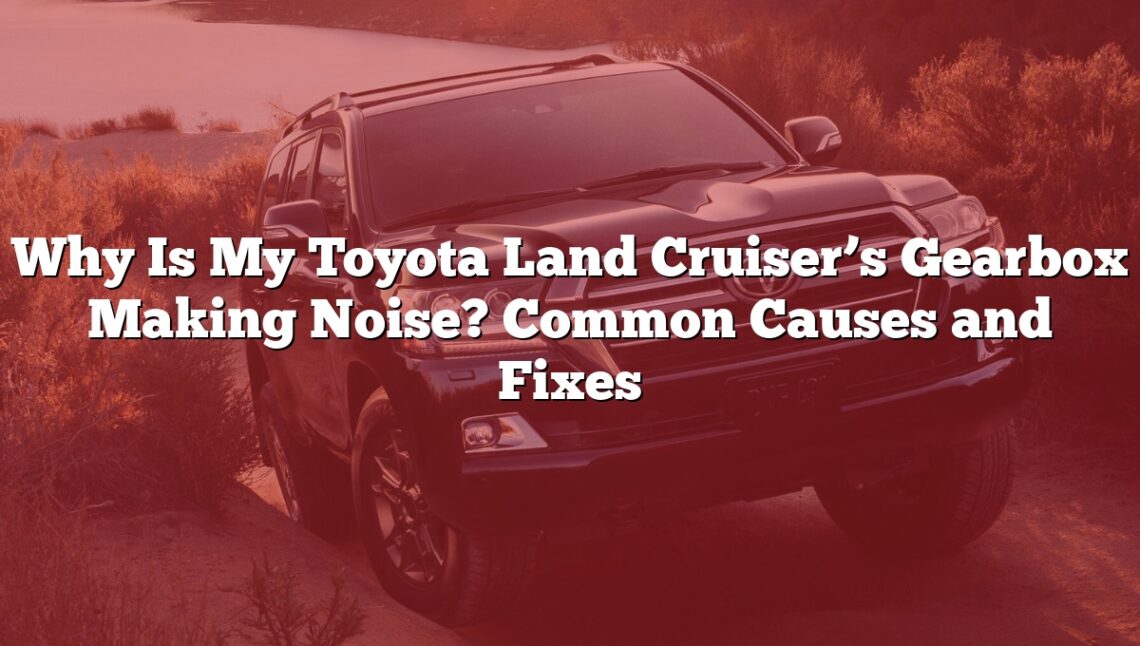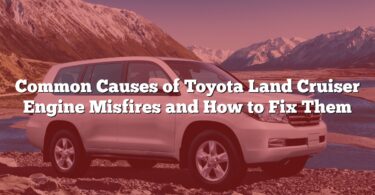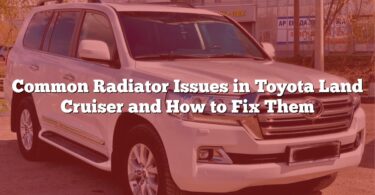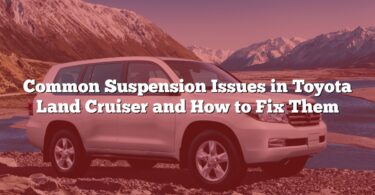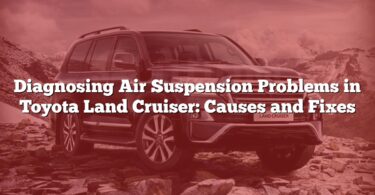If your Toyota Land Cruiser’s gearbox has started making strange noises, it’s not just an annoyance—it could be a sign of a deeper issue. From worn bearings to low fluid levels, a noisy gearbox often points to problems that, if left unchecked, may lead to costly repairs. In this guide, we’ll explore 47 potential causes of gearbox noise and provide practical fixes to keep your vehicle running smoothly. Whether you’re dealing with grinding gears or unusual vibrations, this article will help you diagnose and address the problem effectively.
Guide to Diagnosing and Resolving Gearbox Noise in Toyota Land Cruiser: Problems and Their Solutions
| N° | Problem/Cause | Possible Solution |
|---|---|---|
| 1 | Worn bearings | Replace the bearings with new ones. |
| 2 | Damaged gears | Repair or replace the damaged gears. |
| 3 | Low gearbox oil level | Refill gearbox oil to the appropriate level. |
| 4 | Contaminated gearbox oil | Drain and replace the gearbox oil with clean, manufacturer-recommended oil. |
| 5 | Worn synchronizer rings | Replace the worn synchronizer rings. |
| 6 | Faulty input shaft | Inspect and repair or replace the input shaft. |
| 7 | Faulty output shaft | Repair or replace the output shaft. |
| 8 | Damaged layshaft | Replace the damaged layshaft. |
| 9 | Misaligned gearbox components | Align gearbox components according to manufacturer specifications. |
| 10 | Excessive wear on clutch components | Replace worn clutch components. |
| 11 | Loose or damaged clutch plate | Tighten or replace the clutch plate. |
| 12 | Faulty clutch release bearing | Replace the clutch release bearing. |
| 13 | Damaged universal joints | Replace the damaged universal joints. |
| 14 | Excessive backlash in gears | Adjust or replace gears to reduce backlash. |
| 15 | Broken or worn gear teeth | Replace the affected gears. |
| 16 | Worn or damaged shifter linkage | Repair or replace the shifter linkage. |
| 17 | Incorrectly adjusted clutch | Adjust the clutch to the correct settings. |
| 18 | Damaged or loose flywheel | Replace or tighten the flywheel. |
| 19 | Excessive heat due to poor lubrication | Improve lubrication by replacing gearbox oil. |
| 20 | Vibrations from engine misalignment | Realign the engine and gearbox. |
| 21 | Water ingress in the gearbox | Drain and replace oil, inspect seals, and prevent further water entry. |
| 22 | Improper installation of gearbox components | Reinstall components correctly. |
| 23 | Faulty torque converter (in automatic models) | Repair or replace the torque converter. |
| 24 | Internal component corrosion | Clean and replace corroded components. |
| 25 | Manufacturing defect in gearbox parts | Replace defective parts under warranty, if applicable. |
| 26 | Overloading of the vehicle | Reduce load and inspect for potential damage. |
| 27 | Use of incorrect gearbox oil type | Drain and refill with the correct oil type. |
| 28 | Poor maintenance history | Perform comprehensive maintenance and replace worn components. |
| 29 | Gear grinding during shifting | Inspect clutch system and synchronizers; repair as needed. |
| 30 | Damaged or worn transfer case (if applicable) | Repair or replace the transfer case. |
| 31 | Excessive wear on differential components | Replace or repair the worn components. |
| 32 | Noise from nearby drivetrain components mistaken as gearbox noise | Inspect drivetrain to identify and address the actual source of noise. |
| 33 | Loose or damaged mounting bolts | Tighten or replace the mounting bolts. |
| 34 | Vibrations due to unbalanced driveshaft | Balance or replace the driveshaft. |
| 35 | Transmission fluid leaks | Identify and repair the source of the leak, then refill fluid. |
| 36 | Slipping transmission | Inspect and replace damaged clutches or bands; refill transmission fluid. |
| 37 | Electric component failure | Diagnose and replace faulty electrical components. |
| 38 | Broken flex plate | Replace the flex plate. |
| 39 | Gear shift lock issues | Repair or replace the shift solenoid or other faulty parts. |
| 40 | Transmission overheating | Check and replace burnt or dirty transmission fluid; inspect for blockages. |
| 41 | Burnt or dirty transmission fluid | Replace the fluid and clean the system. |
| 42 | Gunk buildup from overheated transmission fluid | Flush and refill the transmission system. |
| 43 | Clogged transmission fluid filter | Replace the clogged filter. |
| 44 | Transmission pressure issues | Inspect and repair pressure control mechanisms. |
| 45 | Slow gear engagement | Check fluid levels and repair faulty pressure regulators. |
| 46 | Poor vehicle acceleration | Inspect and repair transmission or engine components causing the issue. |
| 47 | Check engine or transmission warning light activated | Perform a diagnostic scan and address the underlying issue. |
Detailed Guide to Diagnosing and Resolving Gearbox Noise in Toyota Land Cruiser: 47 Problems and Their Solutions
1. Worn bearings
Reason:
- Bearings can wear out over time due to friction, lack of lubrication, or contamination.
Solution:
- Replace the worn bearings.
Steps:- Disassemble the gearbox to access the bearings.
- Inspect all bearings for wear or damage.
- Replace with new bearings that match manufacturer specifications.
- Reassemble the gearbox and test for noise reduction.
2. Damaged gears
Reason:
- Gears may crack or wear due to high stress or lack of maintenance.
Solution:
- Repair minor damage or replace the gears if severely damaged.
Steps:- Inspect the gears visually for cracks or worn teeth.
- If repairable, smooth minor damage using professional tools.
- Replace gears that are heavily worn or cracked.
- Reassemble and test gearbox functionality.
3. Low gearbox oil level
Reason:
- Insufficient oil reduces lubrication, causing friction and noise.
Solution:
- Refill the gearbox with the correct amount of oil.
Steps:- Check the oil level using the dipstick or inspection port.
- Refill with manufacturer-recommended oil to the proper level.
- Test drive to confirm the noise is resolved.
4. Contaminated gearbox oil
Reason:
- Dirt or debris in the oil can damage internal components.
Solution:
- Drain and replace the gearbox oil.
Steps:- Drain the old oil completely.
- Flush the gearbox to remove contaminants.
- Refill with fresh, recommended oil.
- Monitor for improved performance.
5. Worn synchronizer rings
Reason:
- Synchronizers help smooth gear shifts; wear leads to grinding or noise.
Solution:
- Replace worn synchronizer rings.
Steps:- Disassemble the gearbox to access synchronizers.
- Remove and replace the damaged rings.
- Reassemble the gearbox and test shifting functionality.
6. Faulty input shaft
Reason:
- Damage to the input shaft causes misalignment and noise.
Solution:
- Inspect and repair or replace the input shaft.
Steps:- Remove the gearbox to access the input shaft.
- Inspect for bends, cracks, or wear.
- Replace if necessary.
- Reinstall and test.
7. Faulty output shaft
Reason:
- Similar to the input shaft, damage causes noise and vibration.
Solution:
- Repair or replace the output shaft.
Steps:- Access the output shaft by disassembling the gearbox.
- Inspect for wear or damage.
- Replace or repair as needed.
- Reassemble and test drive.
8. Damaged layshaft
Reason:
- A damaged layshaft can disrupt power flow in the gearbox.
Solution:
- Replace the layshaft.
Steps:- Disassemble the gearbox.
- Replace the damaged layshaft with a new one.
- Test the gearbox after reassembly.
9. Misaligned gearbox components
Reason:
- Incorrect alignment during assembly causes excessive wear and noise.
Solution:
- Align components properly.
Steps:- Inspect for misalignment during disassembly.
- Realign parts according to manufacturer specifications.
- Reassemble and test.
10. Excessive wear on clutch components
Reason:
- Worn clutch components reduce power transfer efficiency, creating noise.
Solution:
- Replace worn clutch components.
Steps:- Inspect the clutch for wear or damage.
- Replace damaged parts like the clutch plate or pressure plate.
- Test clutch engagement after assembly.
11. Loose or damaged clutch plate
Reason:
- A loose or damaged clutch plate causes uneven power transmission.
Solution:
- Tighten or replace the clutch plate.
Steps:- Inspect for loose or cracked plates.
- Replace faulty components.
- Test for smooth operation.
12. Faulty clutch release bearing
Reason:
- A damaged release bearing causes noise when engaging the clutch.
Solution:
- Replace the clutch release bearing.
Steps:- Access the clutch system by removing the gearbox.
- Replace the bearing.
- Test for noise reduction.
13. Damaged universal joints
Reason:
- Universal joints transfer rotational force and, when damaged, cause vibrations and noise.
Solution:
- Replace the damaged universal joints.
Steps:- Inspect the joints for signs of wear, cracks, or looseness.
- Remove the driveshaft to access the universal joints.
- Replace the damaged joints with new ones.
- Reinstall the driveshaft and test for noise elimination.
14. Excessive backlash in gears
Reason:
- Backlash occurs when there is too much space between gears, leading to clunking noises.
Solution:
- Adjust or replace the affected gears.
Steps:- Measure the backlash using a dial indicator.
- Adjust the gears by repositioning shims or replacing worn gears.
- Reassemble and test the gearbox to ensure smooth operation.
15. Broken or worn gear teeth
Reason:
- Gear teeth can break due to excessive force or wear over time.
Solution:
- Replace the affected gears.
Steps:- Inspect the gears for broken or worn teeth.
- Remove the damaged gears and install replacements.
- Test the gearbox for proper function.
16. Worn or damaged shifter linkage
Reason:
- Worn linkage can cause difficulty in shifting gears and create noise.
Solution:
- Repair or replace the shifter linkage.
Steps:- Inspect the linkage for wear or looseness.
- Tighten connections or replace worn components.
- Lubricate the linkage and test shifting performance.
17. Incorrectly adjusted clutch
Reason:
- Improper clutch adjustment causes uneven engagement, leading to noise.
Solution:
- Adjust the clutch to the correct settings.
Steps:- Check the clutch pedal free play and engagement point.
- Adjust the cable or hydraulic system as needed.
- Test the clutch for smooth operation.
18. Damaged or loose flywheel
Reason:
- A loose or damaged flywheel causes vibrations and knocking sounds.
Solution:
- Tighten or replace the flywheel.
Steps:- Remove the gearbox to access the flywheel.
- Inspect for damage or looseness.
- Tighten bolts or replace the flywheel if necessary.
- Reinstall the gearbox and test.
19. Excessive heat due to poor lubrication
Reason:
- Lack of lubrication increases friction, leading to overheating and noise.
Solution:
- Replace the gearbox oil and ensure proper lubrication.
Steps:- Drain the old oil completely.
- Refill with fresh oil of the recommended grade.
- Test the gearbox under load to ensure smooth operation.
20. Vibrations from engine misalignment
Reason:
- Misaligned engine and gearbox components cause vibrations and noise.
Solution:
- Realign the engine and gearbox.
Steps:- Inspect mounting points for alignment issues.
- Adjust or replace mounts as needed.
- Test the vehicle for reduced vibrations.
21. Water ingress in the gearbox
Reason:
- Water in the gearbox contaminates the oil and damages internal components.
Solution:
- Drain and replace the oil, then seal the gearbox.
Steps:- Drain all oil and inspect for water contamination.
- Flush the gearbox to remove remaining moisture.
- Refill with clean oil and inspect seals for leaks.
- Test the gearbox for noise and performance.
22. Improper installation of gearbox components
Reason:
- Incorrect assembly causes misalignment and noise.
Solution:
- Reinstall components correctly.
Steps:- Disassemble the gearbox and inspect for improper installation.
- Follow manufacturer guidelines to reinstall all components.
- Test the gearbox after assembly.
23. Faulty torque converter (in automatic models)
Reason:
- A damaged torque converter disrupts power transfer, causing noise.
Solution:
- Repair or replace the torque converter.
Steps:- Remove the transmission to access the torque converter.
- Inspect for damage or wear.
- Replace the converter if necessary.
- Reinstall the transmission and test drive.
24. Internal component corrosion
Reason:
- Corrosion weakens internal parts, leading to noise and poor performance.
Solution:
- Clean and replace corroded components.
Steps:- Disassemble the gearbox and inspect for corrosion.
- Replace severely corroded parts.
- Reassemble and test the gearbox.
25. Manufacturing defect in gearbox parts
Reason:
- Faulty parts from the factory can cause persistent issues.
Solution:
- Replace defective parts under warranty if applicable.
Steps:- Identify defective components.
- Contact the manufacturer or authorized service center for replacement.
- Install new parts and test the gearbox.
26. Overloading of the vehicle
Reason:
- Carrying excessive weight strains the gearbox, leading to wear and noise.
Solution:
- Reduce the load and inspect for damage.
Steps:- Remove excess weight from the vehicle.
- Inspect the gearbox and drivetrain for signs of damage.
- Repair or replace any affected components.
- Avoid overloading in the future to prevent recurrence.
27. Use of incorrect gearbox oil type
Reason:
- Using the wrong oil affects lubrication and leads to overheating or damage.
Solution:
- Drain and refill with the correct oil type.
Steps:- Refer to the vehicle manual for the recommended oil type.
- Drain the existing oil completely.
- Refill with the correct oil and test for performance.
- Monitor the gearbox to ensure the issue is resolved.
28. Poor maintenance history
Reason:
- Neglecting regular maintenance leads to cumulative damage over time.
Solution:
- Perform a comprehensive maintenance check and replace worn components.
Steps:- Inspect the gearbox for signs of wear or neglect.
- Replace damaged parts such as seals, gears, and bearings.
- Schedule regular maintenance to avoid future issues.
- Keep records of service to ensure consistent care.
29. Gear grinding during shifting
Reason:
- Misaligned synchronizers or worn clutch components cause grinding noises.
Solution:
- Inspect and repair the clutch system and synchronizers.
Steps:- Test the clutch for proper disengagement.
- Replace worn synchronizers or clutch components.
- Test drive to confirm smooth shifting.
30. Damaged or worn transfer case (if applicable)
Reason:
- A damaged transfer case disrupts power distribution, causing noise.
Solution:
- Repair or replace the transfer case.
Steps:- Inspect the transfer case for damage or wear.
- Replace any faulty components or the entire unit if needed.
- Test the drivetrain after repairs.
31. Excessive wear on differential components
Reason:
- Worn differential parts create vibrations and noises that may resemble gearbox issues.
Solution:
- Replace or repair the worn components.
Steps:- Inspect the differential for wear or damage.
- Replace worn gears, bearings, or seals.
- Test for proper operation and noise reduction.
32. Noise from nearby drivetrain components mistaken as gearbox noise
Reason:
- Vibrations or damage from adjacent components may be misdiagnosed as gearbox issues.
Solution:
- Inspect and address the actual source of the noise.
Steps:- Check the driveshaft, axles, and differential for damage.
- Repair or replace any faulty components.
- Retest the vehicle to confirm the noise is resolved.
33. Loose or damaged mounting bolts
Reason:
- Loose bolts cause misalignment, leading to vibrations and noise.
Solution:
- Tighten or replace the mounting bolts.
Steps:- Inspect all gearbox and engine mounting bolts.
- Tighten any loose bolts to the manufacturer’s torque specifications.
- Replace damaged bolts if necessary.
- Test the vehicle for reduced vibrations.
34. Vibrations due to unbalanced driveshaft
Reason:
- An unbalanced driveshaft creates vibrations that resonate through the gearbox.
Solution:
- Balance or replace the driveshaft.
Steps:- Inspect the driveshaft for signs of imbalance or damage.
- Balance the driveshaft using specialized equipment.
- Replace the driveshaft if balancing does not resolve the issue.
- Test drive to confirm the noise is resolved.
35. Transmission fluid leaks
Reason:
- Fluid leaks reduce lubrication, leading to overheating and noise.
Solution:
- Identify and repair the source of the leak.
Steps:- Inspect the gearbox and surrounding seals for leaks.
- Replace damaged gaskets or seals.
- Refill the gearbox with the correct fluid.
- Monitor for further leaks and noise.
36. Slipping transmission
Reason:
- Worn clutches or low fluid levels cause slipping and noise during operation.
Solution:
- Replace damaged clutches or refill fluid as necessary.
Steps:- Check the fluid level and refill if low.
- Inspect clutch components for wear or damage.
- Replace faulty parts.
- Test the transmission for proper engagement.
37. Electric component failure
Reason:
- Faulty sensors or wiring disrupt transmission function and may create unusual noises.
Solution:
- Diagnose and replace faulty electrical components.
Steps:- Use a diagnostic tool to identify the malfunctioning component.
- Repair or replace the faulty sensor, wiring, or control unit.
- Reset the system and test the transmission.
38. Broken flex plate
Reason:
- A broken flex plate causes uneven power transfer and clunking noises.
Solution:
- Replace the flex plate.
Steps:- Remove the transmission to access the flex plate.
- Inspect for cracks or damage.
- Replace the flex plate with a new one.
- Reassemble and test the vehicle.
39. Gear shift lock issues
Reason:
- The shift solenoid may be broken or jammed.
- Insufficient transmission fluid pressure due to a clogged filter or low fluid.
Solution:
- Repair or replace the shift solenoid and address fluid pressure issues.
Steps:- Inspect the shift solenoid for jamming or failure.
- Clean or replace the solenoid as necessary.
- Check and refill the transmission fluid to the correct level.
- Inspect and replace the transmission fluid filter if clogged.
- Test gear shifting functionality to ensure smooth operation.
40. Transmission overheating
Reason:
- Burnt, dirty, or low transmission fluid reduces cooling efficiency.
- Blockages in the cooling system prevent proper fluid circulation.
Solution:
- Replace the fluid and inspect the cooling system.
Steps:- Drain the burnt or dirty fluid completely.
- Flush the system to remove any blockages.
- Refill with fresh, manufacturer-recommended transmission fluid.
- Test for overheating under normal operating conditions.
- If overheating persists, inspect the cooling system components for repair or replacement.
41. Burnt or dirty transmission fluid
Reason:
- Prolonged use of old fluid leads to buildup and reduced performance.
Solution:
- Replace the fluid and clean the system.
Steps:- Drain the old fluid entirely.
- Clean the gearbox interior using a flushing agent.
- Refill with fresh transmission fluid.
- Monitor performance to ensure the issue is resolved.
42. Gunk buildup from overheated transmission fluid
Reason:
- Overheating causes fluid to degrade, forming gunk that clogs components.
Solution:
- Flush and refill the transmission system.
Steps:- Perform a complete system flush to remove all debris.
- Refill with high-quality fluid as recommended.
- Inspect for further signs of clogging or overheating.
- Test drive to confirm the problem is resolved.
43. Clogged transmission fluid filter
Reason:
- A clogged filter restricts fluid flow, reducing lubrication and cooling efficiency.
Solution:
- Replace the transmission fluid filter.
Steps:- Locate and remove the transmission fluid filter.
- Replace it with a new, compatible filter.
- Refill the system with fresh fluid.
- Test for proper transmission function.
44. Transmission pressure issues
Reason:
- Low fluid levels reduce system pressure.
- Faulty pressure regulators cause inconsistent operation.
Solution:
- Inspect and repair pressure control mechanisms.
Steps:- Check fluid levels and refill if necessary.
- Use diagnostic tools to test the pressure regulators.
- Replace malfunctioning regulators.
- Test the gearbox for normal pressure levels.
45. Slow gear engagement
Reason:
- Low fluid levels delay pressure buildup.
- Worn clutch bands or solenoids impair gear engagement.
Solution:
- Address fluid levels and repair worn components.
Steps:- Refill the transmission fluid to the correct level.
- Inspect clutch bands and solenoids for wear or damage.
- Replace faulty parts.
- Test gear engagement after repairs.
46. Poor vehicle acceleration
Reason:
- Faulty transmission components cause power loss.
- Incorrect fluid levels affect gear engagement.
Solution:
- Repair transmission components and ensure correct fluid levels.
Steps:- Inspect the transmission for worn clutches or damaged gears.
- Replace affected components.
- Refill transmission fluid if needed.
- Test the vehicle for improved acceleration.
47. Check engine or transmission warning light activated
Reason:
- The warning light indicates an issue with the transmission or its related systems.
Solution:
- Diagnose and address the underlying issue.
Steps:- Use a diagnostic scanner to retrieve fault codes.
- Interpret the codes to identify the specific issue (e.g., sensor failure, fluid problem).
- Repair or replace the faulty components.
- Clear the fault codes and test the system to ensure functionality.
Preventing Future Issues
To avoid gearbox noise and ensure the long-term reliability of your Toyota Land Cruiser, follow these proactive steps:
- Perform Regular Maintenance:
- Schedule routine maintenance as outlined in your vehicle’s owner manual.
- Replace transmission fluid and filters at the recommended intervals.
- Monitor Fluid Levels:
- Check transmission fluid levels regularly using the dipstick or inspection port.
- Refill with manufacturer-recommended fluid if levels are low.
- Use the Correct Fluid Type:
- Always use the type of transmission fluid specified for your vehicle.
- Avoid mixing different types of fluids.
- Avoid Overloading:
- Do not exceed the recommended weight capacity for your vehicle.
- Overloading stresses the gearbox and other drivetrain components.
- Practice Smooth Driving Habits:
- Avoid aggressive acceleration and sudden gear shifts.
- Allow the vehicle to warm up before driving in cold conditions.
- Address Problems Early:
- Pay attention to unusual noises, vibrations, or warning lights.
- Have the gearbox inspected at the first sign of an issue.
- Inspect Seals and Gaskets Regularly:
- Check for leaks around the gearbox and repair them promptly.
- Replace worn seals and gaskets to prevent fluid loss.
- Keep the Cooling System in Good Condition:
- Ensure that the transmission cooling system is functioning properly.
- Clean or replace the radiator and cooling lines as needed.
- Use Quality Replacement Parts:
- Always use OEM (Original Equipment Manufacturer) or high-quality parts for repairs.
- Avoid aftermarket parts that may not meet required specifications.
- Drive Responsibly in Off-Road Conditions:
- If using the vehicle off-road, ensure proper use of the transfer case and gears.
- Clean and inspect the gearbox after heavy off-road use.
By implementing these preventive measures, you can reduce the likelihood of gearbox problems and ensure a smoother and quieter driving experience for years to come.

